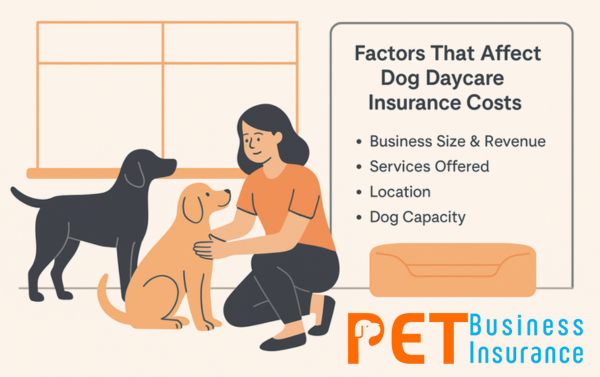
Owning a dog daycare comes with exciting rewards—and serious risks. From dog bites to employee injuries, it’s crucial to have insurance tailored to your unique setup. Unfortunately, most providers don’t clearly explain costs.
At Pet Business Insurance, we believe in transparency. Here’s a guide to help you understand what you might pay for coverage and what factors affect your premium—plus real examples and cost-saving tips.
Quick Cost Snapshot
- Typical Range: $1,500–$12,000+ per year
- Depends on: Business size, services, location, claims history
| Business Type | Revenue Range | Annual Insurance Cost | Common Coverages |
|---|---|---|---|
| Small (Home-Based) | $50k–$100k | $1,500–$3,500 | Liability, Property, Animal Bailee |
| Medium (Commercial) | $100k–$250k | $3,500–$7,000 | Above + Workers’ Comp |
| Large (Full-Service) | $250k+ | $7,000–$12,000+ | Above + Higher Limits, Extra Services |
8 Key Factors That Impact Your Insurance Costs
1. Business Size & Revenue
Larger operations with more revenue typically pay more due to increased risk exposure.
- Small ($75k revenue): ~$2,500
- Medium ($200k revenue): ~$3,750
2. Services Offered
More services = higher liability.
- Boarding: +15–25%
- Grooming: +10–20%
- Transportation: +15–30%
Example: Basic daycare = $3,000. Add boarding and grooming? Expect ~$4,050.
3. Location
Insurance pricing varies based on state regulations, property values, and risks like natural disasters.
- Urban areas can cost 20–40% more
- California: +25–40% over average
- Georgia: Close to national average
4. Dog Capacity
The number of dogs you care for increases your exposure.
- 15 dogs: Base premium
- 40 dogs: Up to 60% more
Example: 12-dog facility = $2,800; 40-dog capacity = ~$4,480
5. Staff Size & Experience
More employees and less experience usually mean higher workers’ comp and liability costs.
- Certified staff and good ratios (more staff per dog) can lower premiums by 10–15%
6. Facility Type
Newer, secure facilities with modern safety features can reduce property and liability insurance by 10–25%.
7. Business Policies
Solid procedures = safer business = lower costs.
- Temperament testing, vaccination proof, spay/neuter rules, and incident tracking can earn you 10–25% discounts.
8. Claims History
A clean history means lower premiums.
- No claims = 10–25% discount
- One claim = 10–20% increase
- Multiple/severe claims = 25–50% increase or policy denial
Essential Insurance Coverages (with Typical Costs)
| Coverage Type | Cost Range | What It Covers |
|---|---|---|
| General Liability | $750–$3,000 | Slip/fall, property damage |
| Professional Liability | $800–$2,500 | Dog injuries, negligence claims |
| Commercial Property | $500–$3,000 | Building, equipment, theft |
| Animal Bailee | $500–$1,500 | Injury/death of dogs in your care |
| Workers’ Comp | $1,000–$2,500/employee | On-the-job injuries |
| Business Owner’s Policy (BOP) | $1,200–$3,500 | Bundled liability + property |
Optional Add-ons:
- Commercial Auto: $1,500–$2,500 (if you offer transport)
- Cyber Liability: $500–$1,500 (for digital booking, customer info)
- EPLI: $800–$3,000 (covers discrimination/wrongful termination claims)
Real-World Insurance Examples
Small Home-Based (GA)
- Revenue: $65,000 | Capacity: 10 dogs
- Services: Daycare only
- Annual Premium: $2,100
Medium Commercial (TX)
- Revenue: $180,000 | 4 employees | 25 dogs
- Services: Daycare + overnight boarding
- Annual Premium: $5,800
Large Full-Service (CA)
- Revenue: $350,000 | 8 employees | 50 dogs
- Services: Boarding, grooming, training
- Annual Premium: $12,500
10 Ways to Lower Your Premium
- Formal safety protocols (temperament testing, incident reporting)
- Bundle multiple policies
- Invest in safety features (non-slip floors, alarms, secure gates)
- Staff training and certifications
- Maintain a claim-free history
- Higher staff-to-dog ratios
- Upgrade to secure facilities
- Use cyber protection if taking digital payments
- Apply for local/state insurance credits
- Work with providers who specialize in pet care
Why Animal Bailee Coverage Is Essential
Even if you have liability insurance, it usually doesn’t cover injury, illness, or death of dogs in your care. Animal bailee fills this critical gap—protecting your business from unexpected vet bills or legal issues, regardless of fault.
